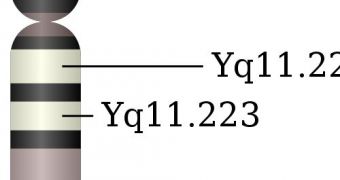According to established knowledge, the Y chromosome in all the males of all species on Earth is a stagnant part of their genetic material. In other words, scientists thought that its only role was to decay over time, causing the genes inside to do the same thing. But a recent comparison of the Y chromosomes of humans and chimpanzees revealed that the structures were in fact evolutionary hot spots, where important changes occurred frequently, ScienceNow reports. The two species in this experiment were selected because they shared 98 percent of genetic information.
“It's really exciting; it's totally well-documented; it's really dramatic,” Andrew Clark, who is a population geneticist at the Cornell University, in the United States, explains. In spite of the fact that we share so much DNA in common with chimps, a lot of the differences that occur (about 30 percent) are located in the region of the Y chromosome alone. This genetic structure plays an important part in determining the gender of a new child, researchers say. The only conclusion that can be drawn from this is that the chromosome has undergone massive changes in the six million years since the early humanoids and chimps are believed to have split from their common ancestor.
The remodeling hypothesis belongs to the Director of the Whitehead Institute, geneticist David Page. The organization is based in Cambridge, at the Massachusetts Institute of Technology (MIT). The new work contradicts almost a century of medical investigations, which have argued that the Y chromosome has a lot less genes than the X chromosome, and that, as such, it must be decaying. Another argument for this idea was the fact that the Y structure seemed to have lost the ability to swap and recombine genes with the X one. This, in turn, suggests a prolonged isolation of the Y chromosome, which currently features just a few hundred genes. The two types of gender-determining structures evolved from an ordinary pair of chromosomes more than 200 million years ago, geneticists say.
Because it remains isolated, and yet evolved, researchers believe that the Y chromosome uses some peculiar mechanisms to change its genetic information. For example, it may be recombining with itself to add new DNA sequences to existing ones, some scientists propose. “Just when we thought we were getting the sense that we had a pretty good picture of what our genome is like and how it evolved, we get tossed this curve ball. There are gems still buried in genomes that we haven't fully uncovered yet,” Duke University geneticist Huntington Willard says.

 14 DAY TRIAL //
14 DAY TRIAL //